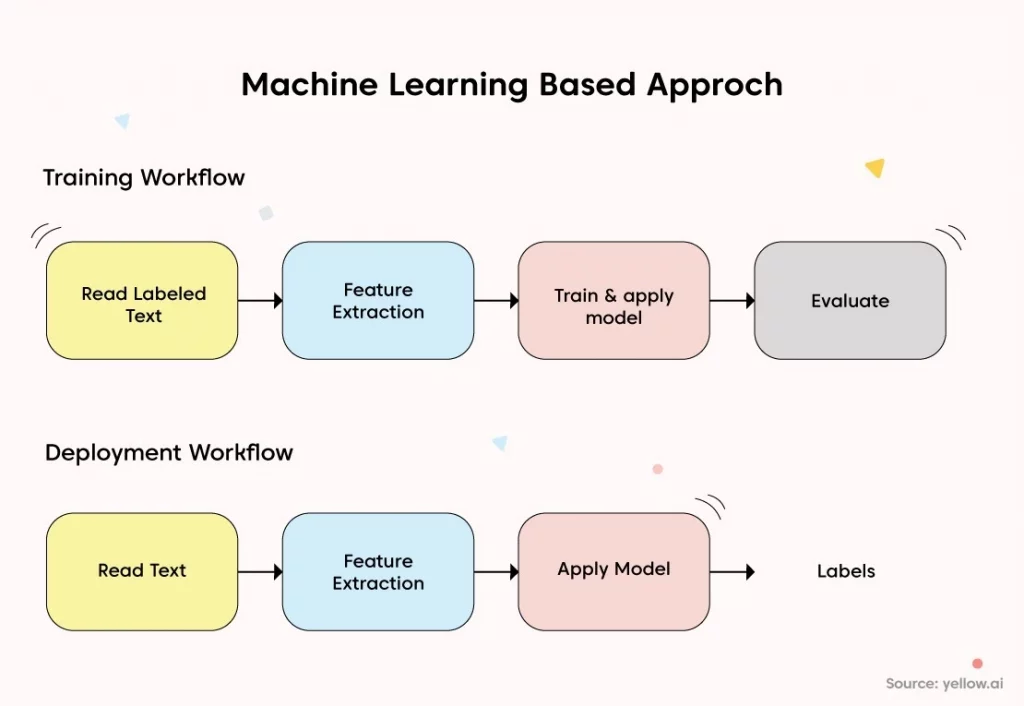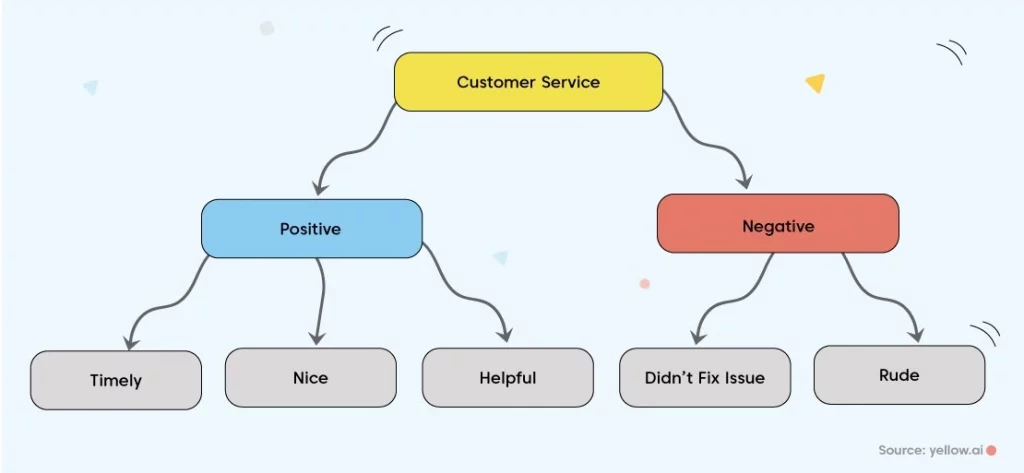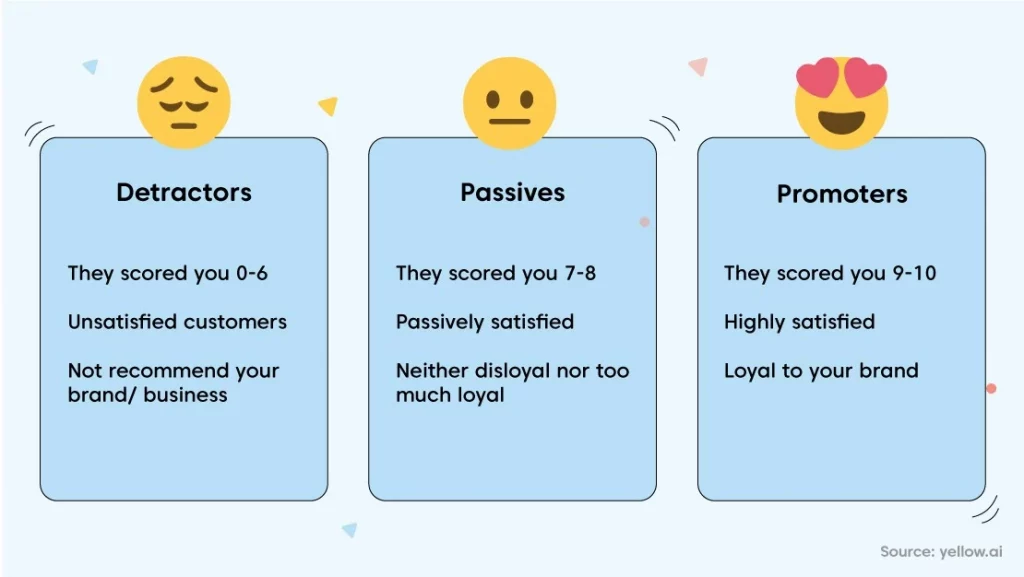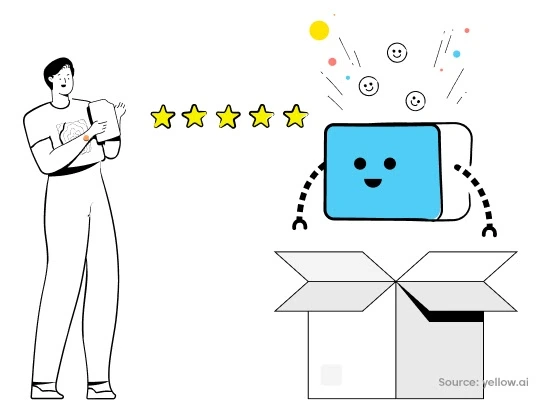Businesses and customers are interdependent on each other in every manner. It’s a fact that these both cannot run without each other. So it is the responsibility of businesses to have a positive impact on the minds of their customers and create an optimistic business environment.
Customer sentiment analysis is nothing but the analysis of different emotions that a customer goes through during and after engaging with your business. Understanding how positive (or negative) do the customers feel about your business is extremely important.
Positive sentiments work as bait for customers, while negative ones act as repellent. Businesses must analyze customer sentiments before it costs them their reputation.
What is customer sentiment analysis?
Customer sentiment analysis is the automated study of understanding customer opinions and emotions about a business’s products, and its total customer experience. It majorly focuses on deriving customer sentiments by processing data in text format using artificial intelligence.
Practically, it is a metric assigned to statements provided by customers as reviews regarding their experience with the company. This metric is also called polarity, ranging from +1 (extremely positive) to -1 (extremely negative).
Various algorithms are used for customer sentiment analysis, but they are majorly bifurcated as the traditional dictionary-based and AI-powered using NLP and machine learning.

The dictionary-based algorithms (without NLP) learn the meanings of the words used by the customer, like “the product I received was poor” or “i completely loved the customer service.” The first statement would have a negative score and the second one would be considered positive.
With machine learning and NLP, the meaning of the complete statement is taken into account. That means a review like, “I am a die-hard fan of this company” would be actually rated positively.
However, customer sentiment analysis is much deeper than just tracking a metric like polarity or NPS (Net Promoter Score). These are actionable insights that need to be addressed with a strategy to improve customer feedback positively.
Is NPS a metric enough for customer sentiment analysis?
Quantitative metrics like NPS are too broad for a business to understand its shortcomings and flaws. It misses a lot of details about how a customer actually feels about the business and the aspect of the reviews provided.
Analyzing the reviews and understanding the pain points that really bother customers is crucial. Focusing on the context of the reviews will make a real difference to your business’s customer experience.
Aspects of customer sentiment analysis
The qualitative analysis of customer sentiments does not help businesses understand what are the customers really satisfied or dissatisfied with. In order to find this, businesses need to understand the aspects behind customer reviews and sentiments.
For example, for a service-based industry, say restaurants, the aspects of customer satisfaction can be ‘health to taste ratio’, ‘value for money’, ‘staff interaction and service’, ‘cleanliness’, and many more.

Diverging the positive and negative customer sentiments under the relevant aspects or themes provide excellent actionable insights. Businesses can observe the comments for an actual scope of improvement in a particular aspect.
Effective customer sentiment analysis must be able to encapsulate the aspects and the themes behind customer feedback and must provide a true picture of their sentiments. It must be able to extract the emotions behind the words because people refer to the same things using a variety of phrases and languages.
A Mckinsey study states the importance of customer sentiment analysis in numbers. It depicts that more than 85% of the customers with positive experiences have purchased more, and more than 70% of customers with a negative experience purchased less.
Benefits and use cases of customer sentiment analysis
Now that we’ve articulated what exactly is customer sentiment analysis, let us understand various benefits and use cases of the same. This knowledge will help you use the analysis to its full potential and obtain better results.
1. Improving customer service for target (negative sentiments) audience
Improving customer service by personally attending to the situation where customers feel strongly negative about the company can help you save the brand reputation. Dissatisfied customers are the greatest learning source for a company, but you cannot learn if you don’t analyze customer sentiment.
With a high negative polarity for a specific business operation, companies must understand the shortcomings and prioritize improving the specific domain.
For example, if your restaurant keeps on getting negative feedback for “value for money”, you might consider analyzing the prices, quality, and quantity of your food products.
2. Analyzing customer sentiments over time
Businesses keep on growing day and night, and so do their customers. Analyzing sentiments with time can keep the company among the leaders in the industry.
Understanding what aspects of your brand are liked and disliked by the customers can keep you up to date in regard to customer expectations.
Businesses also need to revise their customer sentiment analysis aspects over time with changes in societal trends and customer behavior.
For example, after the pandemic, every physical store in the company had to incorporate the aspect of ‘hygiene and sanitization’ to their customer sentiment analysis. Customers were actually attracted to the brands with higher NPS for sanitization.
3. Examining insights to check if a particular section of society has special reviews
Customers from different sections of society are particular about their rules and rituals. Some of your company’s products or services might hurt a section of the population and deteriorate your brand reputation.
For example, in Gujrat, India, Dominos Pizza, the American pizza chain changed its menu to pure vegetarian because people there like to visit only pure vegetarian food joints. This is a great example of customer sentiment analysis and business transformation that came along.
All the global leaders have undergone such transformations as per the society and market they enter into.
4. Identifying key promoters and detractors
NPS is a combined score of all the aspects of customer sentiment analysis. Using data mining and machine learning, companies can understand their key promoters and detractors. With a detailed analysis of all the aspects, businesses can improve on the detractors and even their key promoters to perform better.
By working on detractors, your business can shine through the competitors and become preferred by the customers really soon. Brands can easily improve their NPS by working on the detractors and getting some positive feedback from their customers. This will gain their customers’ trust and loyalty.

5. Understanding change in sentiments with a change in product or service
If a business undergoes some major changes in the product or service, it is important to understand how it is affecting the customers.
By noticing the changes in the customer sentiments, companies can realize if the changes are affecting the brand positively or negatively. Customer sentiment analysis is very important during all business phases, that is, existence, survival, success, take off, and maturity.
If any of the changes go sideways, companies can stop the negative PR from escalating by continuous brand monitoring and sentiment analysis. This can help uphold the brand reputation and stand strong in the market.
6. Refining overall customer service
Deducing customers’ emotions about your customer service can help you improve it in many ways. For example, if a customer is rating negatively for the mode of the communication of customer service, a business can change its mode of communication to a comfortable mode.
Overall customer service ratings depend on a lot of factors, but most importantly if the customer’s problem was solved within a reasonable time. Companies can try new methods for customer service and see the changes in the sentiments of customers. This can prove to be a good practice in the longer run.
7. Improving ROI from marketing campaigns
Businesses can easily analyze through ratings, reviews, social media engagements, and comments if the customers are liking a particular marketing campaign better than others.
In customer sentiment analysis, businesses can easily track and analyze all the social media buzz about the company and understand if any marketing campaigns are getting backlashed or disliked by the customers.
Understanding the emotions of the customers, businesses can improve their marketing campaigns and gain more and more returns from marketing.
Acting upon the customer sentiment analysis result is really important. Customers feel valued and a part of the business when you ask them about their experience and also work on them. Understanding the perspective of customers about the company helps in delivering the best customer experience.
How to do customer sentiment analysis?
By far we have dived into understanding the nuances of customer sentiment analysis and how its results can be applied for achieving growth and delivering quality customer experiences.
How do we obtain those results, how do we understand customer sentiments?
Basically, there are just 2 steps involved, data collection and data analysis. The collected data is trained to the analysis tool or software for drawing actionable insights and conclusions.
Data can be collected through various sources, direct and indirect.
1. Online surveys/forms
After a transaction, companies usually send an email or a message to fill out a form or rate the experience on an NPS. This is for the companies to understand user experience and improve it by working on the comments. Through this data, companies can understand how likely a customer is to recommend your product to a fellow human.

NPS is an industrial growth indicator and is a measure of customer loyalty. An NPS can help companies understand if a customer would affect the brand image in a positive or a negative way.
2. Social media monitoring
Customers speak out their hearts on social media. You can get a true glimpse of what customers think about your brand through social media monitoring.
Words such as ‘good’, ‘love’, ‘excellent’, and ‘hate’, ‘awful’, ‘poor’ can be monitored, if and when used along with your brand name.
Social media insights can be collected through APIs provided by the social media applications for analyzing customer sentiments.
3. Direct customer feedback
Asking the customers directly about their experience with the company or the product is a nice practice. It makes the customers feel valued and also provides a true picture of the customers’ sentiments to the company. This creates a win-win situation for both the customer and the businesses.
Direct customer feedback can be collected during a live chat or call with the customer, or after a transaction, without any surveys or forms.
4. Use a chatbot for collecting customer reviews
Chatbots are excellent in interactions and collecting data for sentiment analysis. After every interaction companies must ask customers for their reviews about the customer experience as well as the products and services.
Companies with chatbots get the privilege of gathering more and more data and running a thorough customer analysis.

As soon as all the data is collected, it can be trained to an in-house sentiment analysis program or can be trained to a third-party platform for analysis. The insights thus received can prove to be extremely beneficial when worked upon.
How can AI chatbots help in customer sentiment analysis?
AI chatbots have a tendency to understand customers’ sentiments by using natural language processing and machine learning. With AI chatbot interactions, there is no need to perform separate sentiment analysis, at least for the interactions occurring through the chatbot. Chatbots are artificially intelligent and can analyze messages coming in from the customers.
Businesses can interact with customers over multiple channels using chatbots and can easily analyze sentiments over all channels automatically. No matter the size of the business, the improvement that can be achieved in customer satisfaction using chatbots and sentiment analysis is absolutely worth the while.
Using Yellow.ai’s chatbot for CX automation, businesses can improve their CSAT by at least 20% and analyze their overall customer experience through a single analytics dashboard.
Companies should opt for an easier way of customer sentiment analysis by installing a chatbot for gathering customer sentiments and also automating a complete customer experience.
Ready to analyze customer sentiments? Schedule a demo with Yellow.ai and understand the opportunities of automating business communication and customer sentiment analysis.
You can also try out our no-code bot builder to create your own chatbot hassle-free. Install a chatbot to your website in less than 10 clicks and upgrade your customer experience to an unbeatable level

















